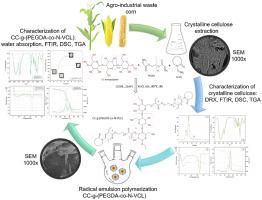Corn cob valorization: Synthesis of a polymer based on crystalline cellulose with poly(ethylene glycol) diacrylate and N-vinylcaprolactam
IF 6.5
Q2 ENGINEERING, ENVIRONMENTAL
引用次数: 0
Abstract
A growing trend in research is the use of agro-industrial waste as a renewable raw material. Cellulose is among the most abundant and versatile biopolymers, which can be derived from agro-industrial waste like corn cobs. This study explored the valorization of corn cob (CM) waste through the extraction of crystalline cellulose (CC) and its modification via radical emulsion polymerization with poly (ethylene glycol) diacrylate (PEGDA) and N-vinylcaprolactam (N-VCL). CC was extracted from CM through pulping, bleaching, and acid hydrolysis, achieving a yield of 67 %. Characterization by scanning electron microscopy (SEM) revealed a fibrillary structure with sizes below 100 μm. X-ray diffraction (XRD) demonstrated a crystallinity index of 98.72 % and characteristic peaks of type I cellulose. Fourier-transform infrared spectroscopy (FTIR) confirmed the removal of hemicellulose, lignin, and amorphous cellulose. Thermal Gravimetric Analysis (TGA) indicated thermal stability up to 369 °C. In the grafted copolymer CC-g-poly (PEGDA-co-N-VCL), with a polymerization yield of 83.91 %, FTIR confirmed the incorporation of PEGDA and N-VCL. SEM analysis revealed a homogeneous three-dimensional surface without visible fibrils, indicating successful grafting. Differential Scanning Calorimetry (DSC) analyses showed transitions at 340 °C, 427 °C, and 460 °C, reflecting enhanced thermal stability, while TGA revealed less gradual degradation in the copolymer, with mass loss stages at higher temperatures. This grafted material exhibited improved thermal stability and lower water absorption than the unmodified CC, highlighting its potential for applications requiring high thermal resistance and moisture control.

玉米芯增值:基于结晶纤维素与聚乙二醇二丙烯酸酯和n -乙烯基己内酰胺的聚合物的合成
研究的一个日益增长的趋势是利用农业工业废料作为可再生原料。纤维素是最丰富、用途最广的生物聚合物之一,它可以从玉米芯等农业工业废料中提取。本研究通过提取结晶纤维素(CC),并通过聚乙二醇二丙烯酸酯(PEGDA)和n -乙烯基己内酰胺(N-VCL)自由基乳液聚合对其进行改性,探讨了玉米芯(CM)废料的再生利用。以CM为原料,经制浆、漂白、酸水解提取CC,收率达67%。通过扫描电镜(SEM)表征,发现其纤维结构尺寸小于100 μm。x射线衍射(XRD)结果表明,其结晶度指数为98.72%,具有I型纤维素的特征峰。傅里叶变换红外光谱(FTIR)证实了半纤维素、木质素和无定形纤维素的去除。热重分析(TGA)表明热稳定性高达369°C。在接枝共聚物CC-g-poly (PEGDA-co-N-VCL)中,聚合率为83.91%,FTIR证实了PEGDA和N-VCL的掺入。扫描电镜分析显示,三维表面均匀,无可见原纤维,表明嫁接成功。差示扫描量热法(DSC)分析显示,共聚物在340°C、427°C和460°C时发生转变,反映了增强的热稳定性,而TGA显示共聚物的逐渐降解较少,在较高温度下存在质量损失阶段。与未改性的CC相比,这种接枝材料表现出更好的热稳定性和更低的吸水性,突出了它在需要高耐热性和湿度控制的应用中的潜力。
本文章由计算机程序翻译,如有差异,请以英文原文为准。
求助全文
约1分钟内获得全文
求助全文
来源期刊

Cleaner Engineering and Technology
Engineering-Engineering (miscellaneous)
CiteScore
9.80
自引率
0.00%
发文量
218
审稿时长
21 weeks
 求助内容:
求助内容: 应助结果提醒方式:
应助结果提醒方式:


